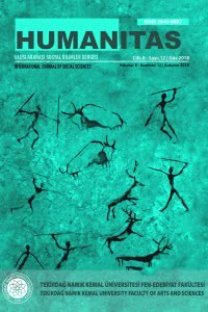SYSTEM GOLDACH: ÜBER KOMMUNIKATION UND SCHEIN IN GOTTFRIED KELLERS KLEIDER MACHEN LEUTE (GOLDACH SİSTEMİ: GOTTFRIED KELLER’NİN KLEIDER MACHEN LEUTE KISA ROMANINDA İLETİŞİM VE GÖRÜNÜM ÜZERİNE)
Alman edebiyatının önde gelen gerçekçi yazarları arasında yer alan Gottfried Keller’in (1819-1890) Kleider machen Leute (1874) adlı yapıtı, farklı sınıflara ayrılmış olan toplumların modern anamalcılığa geçiş sürecinde yaşadıkları üzerine kurgulanmıştır. Yapıtta iki arada bir derede kalmış iki toplumun çelişkileri ve zayıf noktaları, dolandırıcı örgesi kullanılarak eleştirel bir dille aktarılmıştır. Yazar, Seldwyla ve Goldach adında iki ayrı düşsel kent yaratarak, bu kentlerde yaşayan toplumlardaki sınıfsal kırılma ve ayrılmaları belli anlatı kişileri aracılığıyla ortaya koymuştur. Öykü başkişisi gerçekte, yoksul ve işsiz bir terzi çırağı iken varsıl bir dış görünüşü olması nedeniyle, Goldach toplumu tarafından kont gibi karşılanmıştır. Bu gülmeceli durum, sınıfsal ayrışmayı eleştirel açıdan gözler önüne seren çarpıcı bir örnekçedir. Öyle ki bu toplumlar içinde modern anamalcılığın baskın etkisi, kendisini nesneleşme süreciyle dışa vurmaktadır. Bu toplumsal yapı içinde, dış görünüm ve gösterişli nesnelere iye olma durumu bir varsıllık göstergesi ve saygınlığı hak eden bir konumdur. Biz bu çalışmamamızda, Kleider machen Leute adlı yapıtı toplumsal sistemin alt-parça sistemlerden ve iletişimden meydana geldiğini belirten Niklas Luhmann’ın sistem kuramı çerçevesinde çözümlemeyi erek ediniyoruz. Bu yaklaşım bizim, metne içkin olan toplumsal yapıdaki uyuşmazlıkları, daha tutarlı ve doğru biçimde anlamamıza ve açıklamamıza olanak vermektedir.Anahtar Sözcükler: Dolandırıcı Motifi, Görünüş, Toplum, Niklas Luhmann, Sistem Teorisi, İletişimTHE GOLDACH SYSTEM: ON COMMUNICATION AND VENEER IN GOTTFRIED KELLER’S KLEIDER MACHEN LEUTEAbstract: In Kleider machen Leute (1874), written by one of the leading realist German writers, Gottfried Keller (1819-1890), the transition phase of the socially stratified societies’ into modern capitalism is debated in a literary way. In this work, the contradictions and weaknesses of the societies that are stuck in a transitional phase are depicted in a satirical language by using the scoundrel motif. Besides, by creating two different fictional cities called Seldwyla and Goldach, the attention is drawn to the inevitable dependence of the people on the layers in the community. The main character, as an unemployed poor tailor apprentice with a rich appearance treated like an earl by the Goldach society, reveals the social stratification of the society in a critical perspective, due to the consideration that only someone from the upper classes can have a good appearance is still dominant in the society. In this regard, we have shaped our study by taking into consideration Niklas Luhmann’s works on social strata stating that the social system consists of subsystems and communication, and his system theory and the concepts based on this theory. The system theory has enabled us to see the societal discord revealed in the novella and helped us achieve a better reading by contributing a new dimension to the text. Keywords: Scoundrel Motif, Appearance, Society, Niklas Luhmann, System Theory, Communication
Anahtar Kelimeler:
Scoundrel Motif, Appearance, Society, Niklas Luhmann, System Theory, Communication
___
- Aschmann, B. (2013). Preußens Ruhm und Deutschlands Ehre. Zum nationalen Ehrdiskurs im Vorfeld der preußisch-französischen Kriege des 19. Jahrhunderts. München: Oldenbourg.
- Böhler, M. (1990). Keller, Gottfried: Die Leute von Seldwyla. Erzählungen von Gottfried Keller. von Michael Böhler und Y. A. Elsaghe (Hrsg.). Nachwort. (Zweiter Band). Basel: Birkhäuser.
- Bourdieu, P. (1974). P. B.: Zur Soziologie der symbolischen Formen. Strukturalismus und soziologische Wissenschaftstheorie (S. 7-41). Frankfurt a. M.: Suhrkamp.
- Bourdieu, P. (1993). Sozialer Sinn. Kritik der theoretischen Vernunft. Frankfurt a. M.: Suhrkamp.
- Claudio, B. (1997). Giancarlo Corsi, Elena Esposito: GLU. Glossar zu Niklas Luhmanns Theorie sozialer Systeme. Frankfurt a. M.: Suhrkamp.
- Fleig, A. (2008). Märtyrer seines Mantels. Gottfried Kellers Novelle Kleider machen Leute. Der Deutschunterricht, H. 4., 31-41.
- Freund-Spork, W. (2008). Lektüreschlüssel. Gottfried Keller – Kleider machen Leute. Stuttgart: Philipp Reclam jun.
- Goethe, J. W. (2010). Faust-Dichtungen. Stuttgart: Philipp Reclam jun.
- Hondrich, K. O. (2002). Enthüllung und Entrüstung. Eine Phänomenologie des politischen Skandals. Frankfurt a. M.: Suhrkamp.
- Keller, G. (1990). Die Leute von Seldwyla. Erzählungen von Gottfried Keller (Zweiter Band). Michael Böhler und Y. A. Elsaghe (Hrsg.). Basel: Birkhäuser.
- Loetz, F. (2012). „Ständische Gesellschaft“. Historisches Lexikon der Schweiz. Elektronische Ausgabe (e-HLS). URL: http://www.hls-dhs-dss.ch/textes/d/D9928.php (Stand: 18.01.2016).
- Luhmann, N. (1984). Soziale Systeme. Frankfurt a. M.: Suhrkamp.
- ---------------- (1986). Ökologische Kommunikation. Opladen: Westdeutscher Verlag.
- ---------------- (1990). Die Wissenschaft der Gesellschaft. Frankfurt a. M.: Suhrkamp.
- ---------------- (1995). Die Kunst der Gesellschaft. Frankfurt a. M.: Suhrkamp Verlag.
- ---------------- (2002). Einführung in die Systemtheorie. Dirk Baecker (Hrsg.). Heidelberg: Carl Auer Verlag.
- Misch, M. (1982). Der Märtyrer seiner Rolle. Deutschunterricht in Südafrika 2, H. 9, 3-14.
- Richartz, H. (1975). Literaturkritik als Gesellschaftskritik. Darstellungsweise und politisch-didaktische Intention in Gottfried Kellers Erzählkunst. Bonn: Bouvier.
- Sautermeister, G. (1976). Der alte Kanon neu. Zur Revision des literarischen Kanons in Wissenschaft und Unterricht. Walter Raitz und Erhard Schütz (Hrsg.). Erziehung und Gesellschaft in Gottfried Kellers Novelle „Kleider machen Leute“ (S. 176-207). Opladen: Westdeutscher Verlag.
- Selbmann, R. (2007). Erläuterungen und Dokumente. Gottfried Keller – Kleider machen Leute. Stuttgart: Philipp Reclam jun.
- Köppe, T. & Simone Winko (2013). Neuere Literaturtheorien. Eine Einführung. Stuttgart/Weimar: J. B. Metzler.
- ISSN: 2147-088X
- Yayın Aralığı: Yılda 2 Sayı
- Başlangıç: 2013
- Yayıncı: Namık Kemal Üniversitesi
Sayıdaki Diğer Makaleler
Yusuf Ziyaettin TURAN, Raşit ÇOLAK
Ali TİLBE, Sonel BOSNALI, Fatma ER
ALIS VS. ALIENS ADLI ESERDE ANADOLU ÖZLEMİ
Jurnal of Social Sciences HUMANITAS
TİYATRO ESERLERİ ÇEVİRMENİNİN ROLLERİ (THE ROLES OF A DRAMA TRANSLATOR)
ÇİNİNİN SIR ALTINDAKİ SERÜVENİ (THE ADVENTURES OF UNDER GLAZE TILE)
